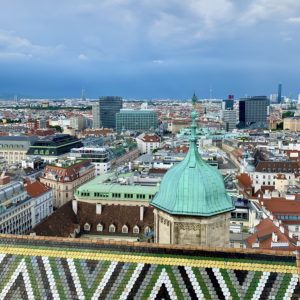
History of Vienna
Founded around 500 BC, Vienna was originally a Celtic settlement. In 15 BC, Vienna became a Roman frontier city, called Vindobona, guarding the Roman Empire against Germanic tribes to the north. During the Middle Ages, Vienna was home of the Babenberg Dynasty. In 1440, Vienna became residence city of the Habsburg dynasties. From this point, the city grew to become the capital of the Holy Roman Empire as well as a cultural center for arts, science, music, and fine cuisine.
Continue reading about the history of Vienna here.

Austria
Austria is a small mountainous landlocked country in South Central Europe. It is bound by Germany and the Czech Republic to the north, Slovakia to the northeast, Hungary to the east, and Slovenia and Italy to the south, as well as Switzerland and Liechtenstein to the west.
As a federal republic, Austria is a parliamentary democracy. The Parliament is made up of two chambers — the national council (Nationalrat) together with the Upper House of Parliament (Bundesrat). With an area of 83,858 sq km, Austria consists of 9 independent federal states — Burgenland, Carinthia, Lower Austria, Upper Austria, Salzburg, Styria, Tyrol, Vorarlberg, and Vienna – each with its own provincial government. Austria is a member of the European Union and the United Nations.
Once the center of power for the large Austro-Hungarian Empire, Austria was reduced to a small republic after its defeat in World War I. Following annexation by Nazi Germany in 1938 and subsequent occupation by the victorious Allies in 1945, Austria’s status remained unclear for a decade. A State Treaty signed in 1955 ended the occupation and recognized Austria’s independence. On 26 October 1955, the Austrian parliament passed a constitutional law that declared the country’s permanent neutrality. This day has been celebrated as Austrian National Day since 1965.
Read more about our host country here.

Danube River
The Danube is the longest river in the European Union and Europe’s second longest river, covering a distance of 2.889 KM (1795 miles). Originating in Germany’s Black Forest, the Danube flows eastward. Passing through ten countries — Germany, Austria, Slovakia, Hungary, Croatia, Serbia, Bulgaria, Romania, Moldova, and Ukraine – the Danube unites the people, religions, cultures, and history of Central and Eastern Europe, before emptying into the Black Sea.
Read more about our chapter’s name sake here.

The Photo and Gustav Klimt
Our website’s background photo was taken by one of our members lucky enough to visit the Stairway to Klimt exhibit at the Art History Museum in Vienna in 2018 on the centenary of the artist’s death. The paintings, completed in 1891, were commissioned by Emperor Franz Josef to depict the history of art. Gustav Klimt, his brother Ernst, and their friend, Franz Matsch, painted the areas between and around the arches and columns of the museum’s majestic stairwell. Situated 12 meters above the ground, one rarely has the opportunity to experience these larger than life characters “eye to eye”.
In this work, Gustav Klimt chose to represent each epoch of art history with female figures. It is believed this mural gave way to a period of mounting experimentation and rebelliousness in his work. In 1897, Klimt and a group of his friends formed a radical group called the Secession which became one of the most important art movements of the era.